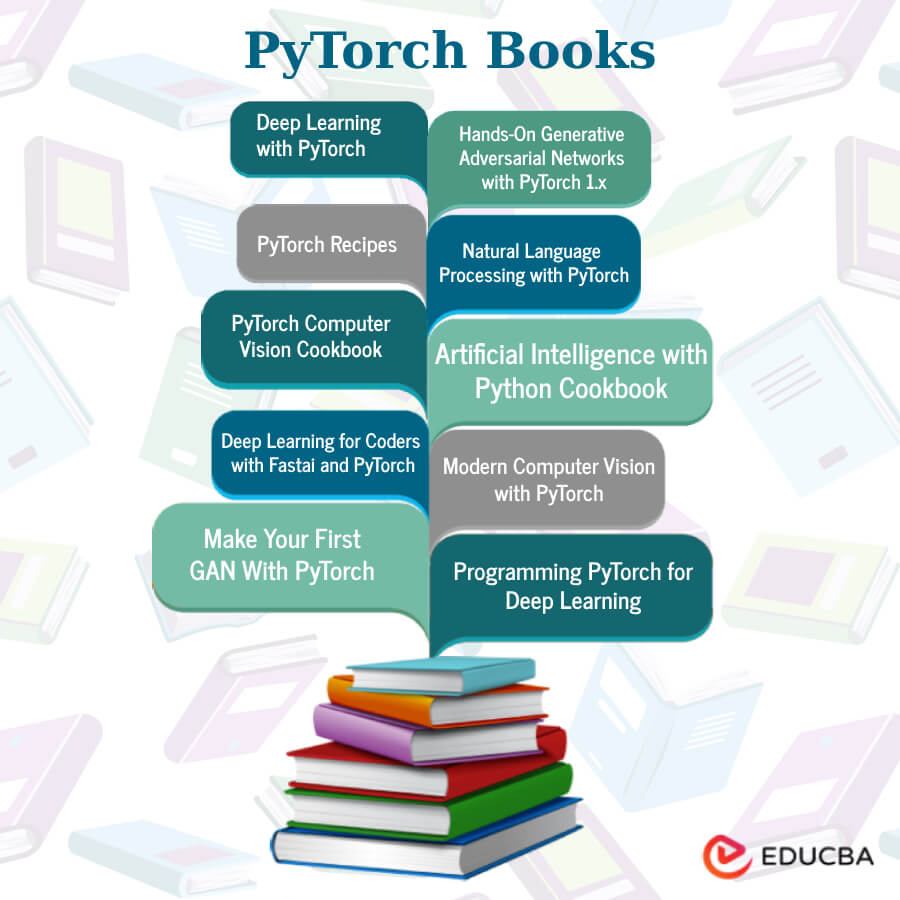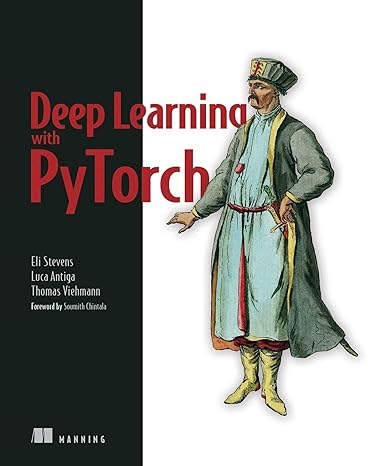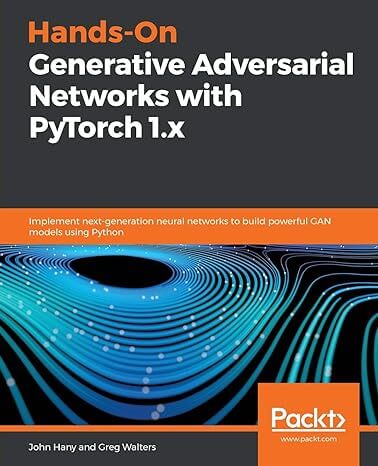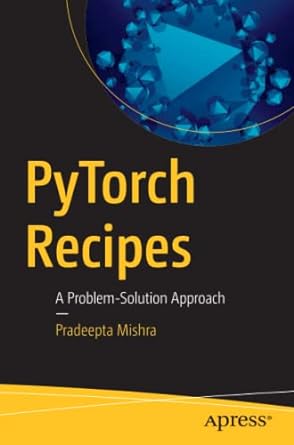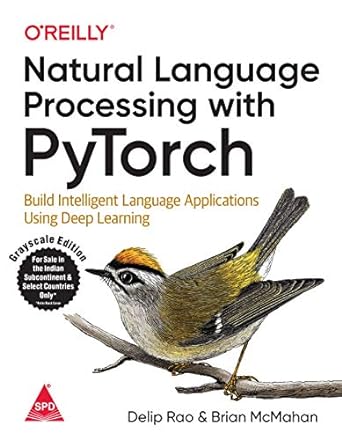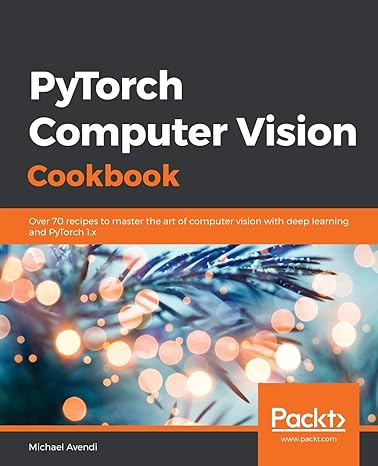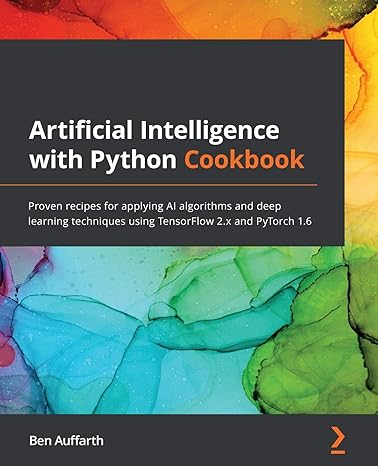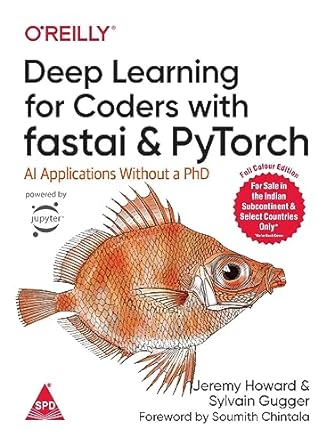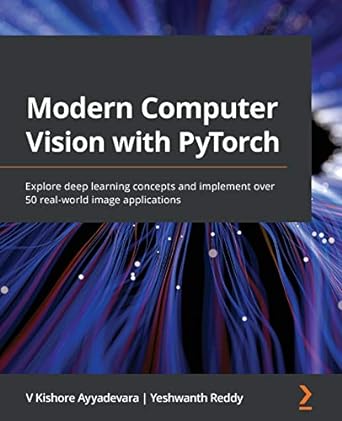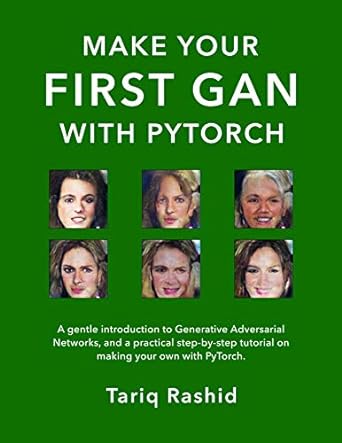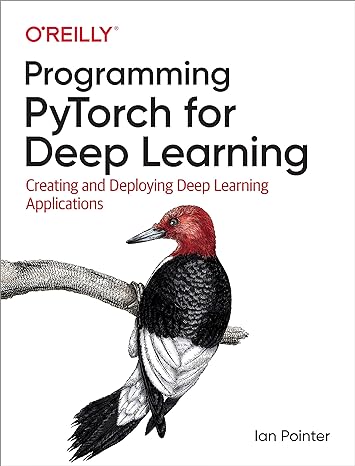Introduction to PyTorch Books
PyTorch is the framework optimized for deep learning, using the Python programming language and Torch library. PyTorch is the most in-demand due to its relative ease of understanding in Python, its flexibility when supporting GPUs, generating manipulable competent gradients, and an interface that promotes faster prototyping and deployment. These PyTorch books provide detailed explanations and practical examples to assist readers in comprehending the topics better.
Key Features
- The books mentioned here aim to train the models in Natural language processing, neural networks, and text processing.
- Build your models with a scratch through NumPy and PyTorch and leverage the use cases of segmentation and object detection.
- Practice Computer vision to perform image processing and learn the technicalities behind real-world examples such as self-driving cars.
- Master tensor methods for dynamic graph-based operations, learn OpenCV functionalities and video classification models on RNN.
Top 10 Books to Learn PyTorch
If you’re interested in PyTorch books, whether you’re a data science professional, PyTorch enthusiast, or a student, these ten books can provide you with comprehensive insights into a range of topics, such as Deep Learning, Adversarial Networks, PyTorch Recipes, NLP, and more. These books can give you a profound understanding of these subjects, PyTorch.
| # | Books | Author | Published | Rating |
| 1. | Deep Learning with PyTorch | Eli Stevens, Luca Antiga, Thomas Viehmann | 2020 | Amazon: 4.4 Goodreads: 4.2 |
| 2. | Hands-On Generative Adversarial Networks with PyTorch 1.x | John Hany, Greg Walters | 2019 | Amazon:4.7
Goodreads: 4.0 |
| 3. | PyTorch Recipes: A Problem-Solution Approach | Pradeepta Mishra | 2019 | Amazon: 2.9
Goodreads:2.0 |
| 4. | Natural Language Processing with PyTorch | Delip Rao, Brian McMahan | 2019 | Amazon:4.1
Goodreads: 3.6 |
| 5. | PyTorch Computer Vision Cookbook | Michael Avendi | 2020 | Amazon:4.5
Goodreads: 3.6 |
| 6. | Artificial Intelligence with Python Cookbook | Ben Auffarth | 2020 | Amazon: 4.4
Goodreads: 3.6 |
| 7. | Deep Learning for Coders with Fastai and PyTorch: AI Applications Without a PhD | Jeremy Howard, Sylvain Gugger |
2023 |
Amazon 4.7
Goodreads- 4.4 |
| 8. | Modern Computer Vision with PyTorch | V Kishore Ayyadevara, Yeshwanth Reddy | 2020 | Amazon 4.6
Goodreads -4.1 |
| 9. | Make Your First GAN With PyTorch | Tariq Rashid | 2020 | Amazon 4.7 Goodreads- 4.6 |
| 10. | Programming PyTorch for Deep Learning | Ian Pointer | 2019 | Amazon: 4.2 Goodreads: 3.7 |
Review the key points provided to gain insights into each PyTorch book, helping you determine which suits your needs.
Book #1. Deep Learning with PyTorch
Author– Eli Stevens, Luca Antiga, Thomas Viehmann
Book Review
A well-planned book when in confusion and a guided manual when in practice, this book can be all you want. The written context of PyTorch is carefully elaborated through examples that touch base upon deep learning principles.
Key Takeaways from Book
- Get introduced to core PyTorch, pre-trained networks, tensor’s powerful functionalities, etc.
- Master combining data sources into a dataset, improve upon training classification models in the medical department, and many more.
Get this book link
Book #2. Hands-On Generative Adversarial Networks with PyTorch 1. x
Author- John Hany, Greg Walters
Book Review
Approach hands-on application of pytorch involving GANs depicted in a thought-provoking manner. The didactic code examples and illustrative methodology make the text easy to follow.
Key Takeaways from Book
- Curate the varied working mechanisms of GAN models, add the functionalities of PyTorch’s latest methods among many more.
- Experience the unpaired image collections with CycleGAN, generate a point cloud of 3D objects, and learn the technicalities behind SEGAN.
Get this book link
Book #3. PyTorch Recipes: A Problem-Solution Approach
Author- Pradeepta Mishra
Book Review
Experience this book’s gripping power, packed with tensors, probability distributions, transformations, and graph computations. It also throws light on common misconceptions faced with neural network implementation.
Key Takeaways from Book
- Build tensor methods for dynamic graph-based operations using the PyTorch, curate transformations for neural networks, and perform LSTM models.
- Work on supervised and unsupervised learning with the help of PyTorch, use it for text processing, and many more such things.
Get this book link
Book #4. Natural Language Processing with PyTorch
Author- Delip Rao, Brian McMahan
Book Review
Nurture a strong foundation in PyTorch from the ground up using functional design patterns that are easily accustomed to any given use case. This book’s sheer simplicity will make you efficient in representing text input in a model and practicing maintainable code.
Key Takeaways from Book
- Learn the fundamentals of PyTorch optimized tensor manipulation library and NLP concepts and build neural networks.
- Carry out embedding to showcase prominent features, generate sequence-to-sequence models, and go through design patterns.
Get this book link
Book #5. PyTorch Computer Vision Cookbook
Author- Michael Avendi
Book Review
Fortitude through the trickiest problems in Computer vision by brushing up on your neural networks and deep learning skillset. Utilize the PyTorch 1. x adaptability to upscale your performance in image classification, object detection, and more of the like.
Key Takeaways from Book
- Fine-tune and change hyperparameters to train deep learning algorithms and practice classification and detection in the Computer vision domain.
- Optimize thorough understanding of neural style transfer network on CNNs and video classification models on RNN, LSTM, and 3D-CNN.
Get this book link
Book #6. Artificial Intelligence with Python Cookbook
Author- Ben Auffarth
Book Review
Push past hurdles of Artificial intelligence when you have this wonderful gem of a book that is dead set on simplifying AI with TensorFlow and pyTorch’s extensive use cases. Learn to visualize data using Keras and Pytorch and supplement yourself with probabilistic modeling.
Key Takeaways from Book
- Familiarize yourself with supervised machine learning, data preprocessing methods, and adversarial autoencoders.
- Get the gripping knowledge on knowledge embedding, swarm algorithms, and deploy models as microservices.
Get this book link
Book #7. Deep Learning for Coders with Fastai and PyTorch: AI Applications Without a PhD
Author- Jeremy Howard, Sylvain Gugger
Book Review
If you feel like you are getting rusty, roll up your sleeves with this book because you will be entranced into the world of FastAi, a smooth interface to PyTorch, Pandas, and Numpy. The contents of this book is available on Google Colab in the form of jupyter notebooks.
Key Takeaways from Book
- Prime models in computer vision and tabular data and upscale accuracy and reliability of deep learning models while learning the same.
- Practice building models from scratch, follow ethical principles, and gain insights from the founder of PyTorch itself!
Get this book link
Book #8. Modern Computer Vision with PyTorch
Author- V Kishore Ayyadevara, Yeshwanth Reddy
Book Review
Bring the glorious charm of deep learning into your hands with the addition of this book into your arsenal when dealing with the likes of segmentation and GANs. Each subsection provides implementable code with the skilled mechanics to get things started.
Key Takeaways from Book
- The content contains implementing 2D and 3D multi-object detection, generating digits and DeepFakes, and deploying models on the AWS server.
- Incorporate images using CycleGan and Pix2PixGAN and infuse CV with NLP to practice image captioning.
Get this book link
Book #9. Make Your First GAN With PyTorch
Author- Tariq Rashid
Book Review
Make artificial neural networks your best accomplice with this handy book to discover the nuts and bolts of how everything works together. The mathematics behind GANs is demonstrated concisely to correlate things efficiently.
Key Takeaways from Book
- Overview of generating higher quality images through convolutional GANs and calculating ideal loss values for building balanced GANs.
- Lays the CUDA GPU acceleration, fabricates full-color human faces, and discovers the remedies for failed GANs.
Get this book link
Book #10. Programming PyTorch for Deep Learning
Author- Ian Pointer
Book Review
A much-needed book for jumpstarting into Pytorch that avails to you the information in a step-level order, starting from the minutia and taking it to the highest level. The content progressively moves from images to NLP, and finally to speech IMO, which proves very beneficial.
Key Takeaways from Book
- Broaden your learnings through PyTorch’s various use cases, apply transfer learning to images, and learn through a model trained on Wikipedia.
- Debug PyTorch models, gh tensorboard, and flame graphs and practice running them on docker containers and Kubernetes on Google.
Get this book link
Recommended Books
We hope that this EDUCBA information on “PyTorch Books” benefited you. You can view EDUCBA’s recommended articles for more information.
